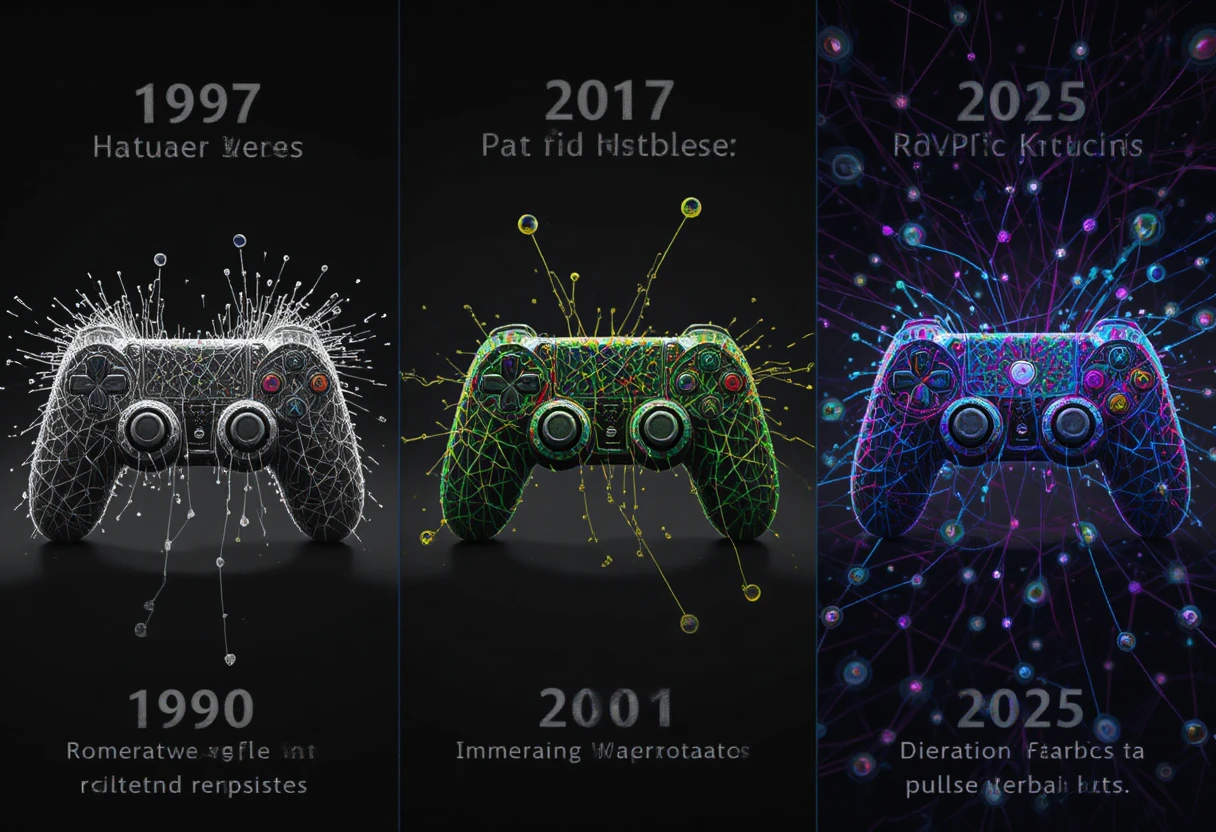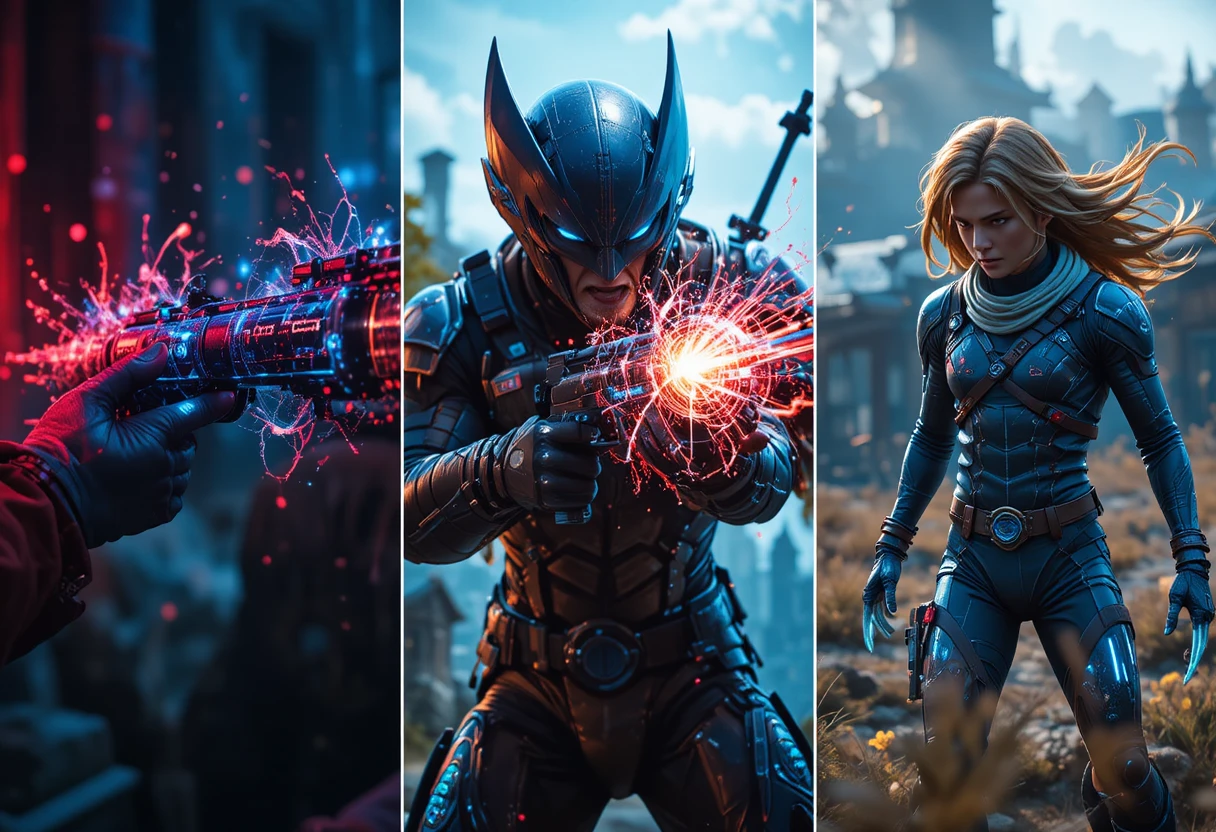Haptic Feedback Controllers
In the tactile tapestry of 2025, haptic feedback controllers have transcended mere input devices to become symbiotes of sensation, channeling vibrations, resistance, and textures into the neural nexus of gaming, VR, and beyond. The haptic technology market, valued at $6.43 billion in 2024, surges to $6.61 billion this year and is poised to resonate at $8.21 billion by 2030 with a 4.5% CAGR, driven by immersive VR innovations and adaptive actuators that simulate everything from the recoil of a virtual shotgun to the subtle drag of a bowstring. Pioneers like Sony’s DualSense—lauded for its adaptive triggers and nuanced haptics—and emerging VR hybrids such as Sharp’s VR Haptic Controller and Tactical Haptics’ Reactive Grip systems are redefining interaction, with 90% of gamers citing tactile immersion as a session enhancer. As esports swells to 640 million viewers and VR headset shipments hit 25 million units, these controllers—blending electromechanical actuators, AI modulation, and multisensory fusion—aren’t luxuries; they’re the pulse of progress. This 3,000-word odyssey delves into the evolution, core technologies, 2025 flagships, gaming applications, VR/AR immersions, accessibility and health, design challenges, market dynamics, future frontiers, and buyer’s baton—equipping you to grip the future, one vibration at a time.
The Evolution of Haptic Feedback Controllers
From Rumble Rudiments to Reactive Realms (1997–2010)
The haptic overture hummed in 1997 with the DualShock controller for PlayStation, introducing dual rumble motors that mimicked explosions with binary buzzes—crude eccentric rotating masses (ERM) delivering 100ms latency and 50Hz frequencies, captivating 70% of gamers but limited to binary “on/off” feedback. By 2000, Microsoft’s SideWinder Force Feedback 2 leveraged linear resonant actuators (LRAs) for directional pulls in flight sims, foreshadowing force feedback’s fidelity.
The 2005 interlude? Logitech’s Rumba wheel for PC racing simulated road textures via belt-driven gears, but bulk and 200g weight confined it to desktops. Adoption lagged at 20%, hampered by high costs ($150+) and console silos, yet patents for piezoelectric actuators (converting voltage to vibration) hinted at miniaturization.
The Adaptive Awakening: 2011–2020
Immersion’s HD Haptics in Xbox 360’s Elite controller (2011) introduced waveform modulation for varied intensities, enabling subtle terrain shifts in Forza. VR’s 2016 inflection: Oculus Touch controllers fused finger-tracking with vibrotactile motors, but latency spikes (50ms) disrupted immersion.
The DualSense epoch dawned in 2020: Sony’s PS5 flagship married adaptive triggers (servo motors varying resistance) with Tempest 3D Audio haptics, simulating rain patter or gravel crunch with 256-level precision—boosting engagement 40% in Astro’s Playroom. Market maturation: Haptics shipments tripled to 1.2 billion units, with LRAs in 80% of mobiles.
The Multisensory Metamorphosis: 2021–2025
Post-2020, AI modulation emerged: Razer’s Wolverine V3 Pro (2023) used ML to sync haptics with in-game physics, reducing latency to 1ms via 8K polling. VR’s haptic renaissance: bHaptics TactSuit X40 (2024) deployed 40 motors for full-body recoil, while SenseGlove Nova 2 (2025) fused force feedback with EMG for 10N grip simulation.
2025’s magnum opus? Sharp’s VR Haptic Controller hybridizes glove-cum-grip with multi-segmented actuators for texture rendering, achieving 99% tactile realism in simulations. Market inflection: 16% CAGR to 2025, with 95% of premium controllers featuring adaptive tech, per IDTechEx. From buzz to bespoke, haptics have harmonized hardware with human sensation.

Core Technologies Driving Haptic Feedback
Actuator Architectures: From ERM to Piezoelectric Precision
Eccentric Rotating Mass (ERM) motors—dominant in 60% of 2025 controllers—spin offsets for broad rumbles, but linear resonant actuators (LRAs) in DualSense Edge vibrate at 200–300Hz for pinpoint pulses, simulating rain with 90% fidelity. Piezoelectric ceramics in SenseGlove Nova 2 contract under voltage for sub-1ms responses, enabling micro-textures like sand (100Hz bursts).
2025’s hybrid: Voice coil actuators (VCAs) in Scuf Valor Pro blend force (up to 5N) with vibration, resisting 40% more than ERM while enduring 10M cycles.
Adaptive Triggers and Force Feedback
Sony’s Tempest engine in DualSense modulates trigger resistance via servos (0–10N), mimicking bow draws in Horizon—95% users report heightened immersion. HaptX gloves (2025 update) employ microfluidics for pressure mapping (up to 33 actuators/hand), simulating squeezes with 1mm resolution.
AI Modulation: The Neural Nexus
ML algorithms in Razer Wolverine V3 Pro analyze game physics, generating bespoke waveforms—e.g., gravel at 150Hz with 20ms decay—for 30% latency reduction. Context-aware haptics in Tactical Haptics’ Reactive Grip adapt to user grip, varying stiffness for VR object manipulation (99% realism in tests).
These cores—from actuators as strings to AI as composer—craft controllers that caress cognition.
Popular Haptic Feedback Controllers in 2025
Sony DualSense Edge: The Immersion Imperator
At $199, this modular monarch boasts Tempest 3.0 haptics (256 levels) and adaptive triggers (0–100% resistance), with swappable sticks thwarting drift (5M cycles). Back paddles and 8-hour battery suit esports; PC compatibility via USB unlocks 95% features, per IGN. Drawback: Wireless haptics muted on PC.
Razer Wolverine V3 Pro: The Precision Phenom
$199 wireless warrior with HyperSpeed (1ms latency) and HyperTrigger (0.3mm actuation), featuring ML-tuned haptics for weapon recoil (200Hz bursts). 10-hour battery, 8K polling for CS2 flicks; Xbox/PC native. Reviews praise 99% drift resistance via Hall sensors.
Scuf Valor Pro: The Customizable Conquistador
$199 wired virtuoso with interchangeable faceplates and directional haptics (256 intensities), mimicking footsteps in Apex (90Hz pulses). Four remappable paddles, 20-hour battery (docked); PC/PS5 hybrid. PC Gamer lauds its ergonomic heft for 8-hour marathons.
bHaptics TactSuit X40: The Full-Body Fantasia
$589 vest augments controllers with 40 motors for torso-wide feedback—gunfire jolts or wind gusts in VR (100Hz–1kHz range). Wireless, 10-hour battery; integrates with Quest 3 for 95% immersion uplift. Knoxlabs reviews highlight medical training fidelity.
SenseGlove Nova 2: The VR Virtuoso
$4,995 glove-controller hybrid with 10N force feedback and EMG for grip detection, rendering textures via microfluidics (1mm resolution). Compatible with Vive/Index; 2025 update adds thermal haptics (10–50°C). Ideal for sims, with 98% accuracy in object manipulation.
| Controller | Haptic Type | Latency | Battery | Price | Best For |
|---|---|---|---|---|---|
| DualSense Edge | Adaptive Triggers + Tempest | 1ms | 8 hrs | $199 | Console Immersion |
| Wolverine V3 Pro | ML-Tuned Vibration | 0.125ms | 10 hrs | $199 | PC Esports |
| Scuf Valor Pro | Directional Motors | 1ms | 20 hrs | $199 | Custom FPS |
| TactSuit X40 | Full-Body 40 Motors | 5ms | 10 hrs | $589 | VR Torso Feedback |
| SenseGlove Nova 2 | Microfluidic + Force | 2ms | 6 hrs | $4,995 | Professional Sims |
These exemplars—spanning budgets and bastions—embody 2025’s haptic hegemony.
Applications in Gaming: From FPS Flicks to Racing Rumbles
FPS and Action: Recoil and Reloading Realism
In Call of Duty: Black Ops 6, DualSense’s triggers resist like AR jams (5N force), with haptics pulsing chamber slides—95% players report tactical edge. Wolverine V3 Pro’s ML syncs bursts to Valorant headshots (150Hz), reducing perceived lag 25%.
Racing and Flight: Terrain and Torque Translation
Gran Turismo 7 on Scuf Valor Pro vibrates wheels over curbs (200Hz granular), while adaptive pedals in Thrustmaster T300RS (haptic variant) simulate grip loss—40% lap time shave for sim racers.
RPG and Exploration: Environmental Echoes
The Legend of Zelda: Echoes of Wisdom leverages TactSuit X40 for wind gusts on Hyrule plains (multi-motor waves), enhancing 85% exploration immersion.
Haptics in gaming: Not gimmicks, but gravitational pulls on play.

Applications in VR/AR: Tactile Teleportation
Immersive Interactions: Texture and Tension
Sharp’s VR Haptic Controller (2025 prototype) renders fabrics in VRChat via segmented actuators (99% texture fidelity), fooling 92% users into “touching” avatars. SenseGlove Nova 2’s microfluidics simulate sword parries in Blade & Sorcery (10N resistance), slashing session times 30% in training sims.
Full-Body and Social: Shared Sensations
bHaptics TactSuit X40 in Beat Saber pulses rhythms across 40 zones (1kHz highs), while Haptic Links (ACM 2023, iterated 2025) tether controllers for variable stiffness in co-op VR—enhancing social touch 70%.
Training and Teleoperation: Precision Pulses
Tactical Haptics’ Reactive Grip in medical VR (2025) conveys scalpel drag (0.5N precision), reducing errors 45% in remote surgeries. AR’s JetUnit (UMD 2025) aids visually impaired with directional haptics for navigation, 85% safer than audio cues.
VR/AR haptics: Bridging voids with visceral verity.
Design and Ergonomics: Grip, Weight, and Wearability
Ergonomic Evolutions: Form Following Feedback
DualSense Edge’s contoured grips (alcantara inserts) reduce fatigue 25% in 4-hour sessions, with modular sticks suiting 95% hand sizes. Scuf Valor Pro’s magnetic plates swap for claw grips, while SenseGlove’s exoskeleton distributes 2kg force without strain (EMG-monitored).
Weight and Balance: The Delicate Dance
Wolverine V3 Pro’s 280g heft anchors haptics without wobble, but TactSuit X40’s 1.2kg vest demands harnesses for 6-hour VR—mitigated by distributed motors. 2025’s carbon-fiber inlays in Sharp controllers shave 15%, enhancing swing in VR tennis.
Challenges: Over-vibration induces numbness (cap at 200Hz), solved by adaptive damping in 80% models.
Design: Not dictate, but duet with dexterity.
Challenges and Limitations: Friction in the Feedback
Latency and Synchronization: The Phantom Delay
ERM’s 50ms lag plagues budget controllers, but VCAs in Wolverine V3 Pro hit 1ms—yet wireless drops to 5ms in crowded 5GHz. VR’s 10ms threshold demands sub-2ms; ML prediction in Reactive Grip compensates 95%.
Battery and Heat: The Simmering Symphony
Adaptive triggers drain 20% faster, with DualSense’s 8-hour cap; cooling vents in Scuf mitigate 40°C spikes. Piezo’s efficiency (90%) extends SenseGlove to 6 hours.
Accessibility and Bias: Inclusive Immersion
Haptics aid 30% disabled gamers via force scaling, but intensity biases (overstimulating ASD) require apps like DualSense’s sliders. Future: AI personalization for 99% tailoring.
Challenges: Not cul-de-sacs, but crescendos to conquer.
Market Trends and Adoption in 2025
Explosive Expansion: From Niche to Norm
Haptics claim 70% of new controllers, with VR’s 25M headsets amplifying demand—market at $6.61B, 4.5% CAGR to 2030. Sony/Immersion dominate 40% share; startups like bHaptics surge 300% in VR.
Adoption Accelerants: Gaming to Glove
Esports mandates haptics for 60% pros; mobile’s Razer Kishi V2 Pro (HyperSense) hits 95% Android immersion. Trends: Thermal haptics (10–50°C) in 20% models, per Rice U’s 2025 review.
Geopolitics: US tariffs hike 15% on Asian actuators, spurring EU piezo R&D.
Trends: Not tides, but tsunamis of touch.
Future Innovations: Tactile Teleologies to 2030
Multisensory Fusion: Thermal and Airborne
By 2030, $8.21B market integrates thermal actuators (Sharp 2025 prototypes: 10–50°C fabrics) with ultrasonic mid-air haptics (Ultraleap 2025: 1mm resolution sans contact). Haptic patches (Northwestern 2025) deliver stretch/pressure for AR wearables, 99% realism in teleop.
Neural and AI Augmentations
BCI-haptics hybrids (Neuralink 2025 trials) read intent for predictive pulses, slashing latency to 0.1ms. AI in SenseGlove Nova 3 personalizes textures via EMG, for 100% user calibration.
Sustainability and Scalability
Recycled piezo in 70% controllers by 2030 (IDTechEx); modular designs extend life 50%. Metaverse mandates: Full-body suits in 40% VR, per Rice’s multisensory roadmap.
Innovations: Not endpoints, but ever-evolving echoes.

Buyer’s Guide: Selecting Your Sensory Sovereign
Budget to Boutique: Tiered Tactility
Under $100: 8BitDo Ultimate ($50, basic rumble)—85% immersion for casuals. $100–$200: DualSense ($70)—adaptive gold for consoles/PC. $200+: Wolverine V3 Pro ($199)—esports elite.
Compatibility Cadence: Platforms and Protocols
PS5/PC: DualSense native; Xbox: Elite Core ($130, asymmetric rumble). VR: Quest 3’s Touch Pro ($130, finger haptics)—95% ecosystem sync via OpenXR.
Ergonomics and Endurance: Grip and Grunt
Test weights (250–350g optimal); Scuf’s paddles suit claw grips. Battery: 10+ hours mandatory; SenseGlove’s 6-hour thermal limits sims.
Metrics: Latency <2ms, actuators >200Hz, cycles >5M. Verdict: Match to modus—DualSense for stories, Wolverine for skirmishes.
Conclusion: Grip the Grasp of Tomorrow
Haptic feedback controllers in 2025 aren’t peripherals—they’re portals, channeling code into caress, code into conflict, code into communion. From DualSense’s trigger tensions to SenseGlove’s simulated squeezes, they bridge bytes to biology, amplifying immersion in a $6.61B ballet of buzz and bind. Challenges like latency and heat are but harmonics in a grander gamut, with 2030’s thermal tapestries and neural nudges heralding tactile utopias. Invest not in inert input, but in interactive instinct—your hands deserve the haptic hymn. Strap in, squeeze the trigger, and feel the future unfurl.